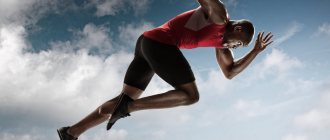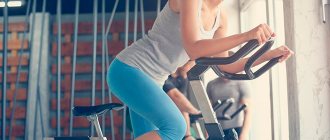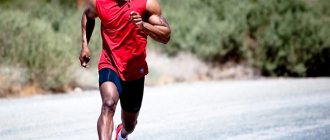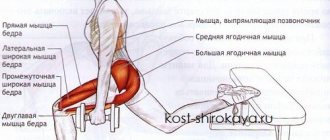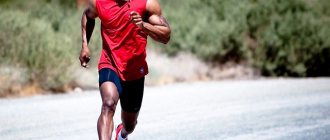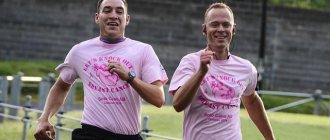If you're determined to track your running performance, you've probably already learned about the existence of a running pace calculator. This tool is available in all sports gadgets and applications. If you have noticed, there are two types of measurements in calculators: pace and speed, and many beginners confuse these concepts.
Let's remember the school mathematics course - how to calculate speed? That's right, you need to divide the distance by the time interval. Enter the distance into the calculator, accurate to the nearest meter, and indicate the exact number of minutes and seconds. You will receive a result in km/h, which shows your average driving speed. That is, how many kilometers will you cover in 1 hour?
Running pace is the opposite of average speed, it shows how long it takes a runner to cover a specific distance and is measured in min/km. That is, how many minutes does it take for a person to run 1 km? Thus, if you control this parameter, you can approximately calculate how long it will take to complete the distance.
Usually, apps with calculators automatically notify the runner about changes in pace; he only needs to set the frequency of notifications. Most often, the interval is set at 5-10 minutes. This way you will constantly monitor the productivity of your run.
Online running speed and pace calculators are now available on all resources dedicated to sports and physical education. A person only needs to enter data on the mileage traveled and the time spent on it, and then press the “calculate” button. In a second he will see the indicators.
What it is?
Pace is the amount of time it takes a person to run one kilometer.
If we go deeper into the concept, it sounds like this:
This is the reciprocal of the average running speed. This value fully characterizes the speed of a person’s movement; it is equal to the average time it takes to travel one mile or kilometer. Pace and its unit are often used in distance running, race walking and racing.
Running pace is measured in minutes and seconds in miles or kilometers, the choice depends on the person and his preferences. If it is easier to navigate by miles, then they should be taken as a measure.
To conveniently calculate your personal running pace, several formulas have been invented that are actively used by athletes to draw up graphs, because the main task of the pace is to be able to show exactly how much time a person spends covering a certain distance.
By calculating his average pace, he will be able to understand how much time it will take him to cover the entire distance.
Before calculating the pace, beginners are most often given the same advice: stick to running at a certain speed. But each type of running will require its own pace, so athletes need to know how much energy it will take them.
Training program
To successfully meet the 3 km standard, you need to choose the right training program and strictly follow it. Experts recommend the following method of training if there are several months left before passing the standards or competitions: the entire period should be divided into 3 equal parts and left 1.5-2 weeks immediately before the race. These parts are also called training cycles.
In the first cycle, you need to gain basic running training. To do this, you should practice running slowly over a distance of 3 to 10 km. In addition, once a week you need to do strength training for your legs and upper body.
In the second cycle, it is necessary to include interval running in the training program. For example, divide a distance of 6 km into 6 equal segments and run each segment alternating between slow and fast paces.
In the third cycle of the training program, the athlete should add sprint running, that is, develop speed and speed by running distances of 100-200 meters.
When there are 1-2 weeks left before the final race for three rubles, it is recommended to significantly reduce the amount of physical activity in order to give the body sufficient time to rest and recover. For example, strength training and sprint running should be excluded completely, and interval running and distance running should be retained, but performed less frequently (2-3 times a week).
How to calculate your average running pace?
Beginners during their first running training need to monitor the time they spend over a certain distance. Without these observations, it will be difficult for them to calculate for themselves their average pace, which should be followed in training. The concept itself speaks for itself and indicates the average amount spent on running.
Distance 5 km, Time 25 minutes. The average pace is 25 / 5 = 5 minutes. A runner runs 1 km in 5 minutes on average. This is the average running pace in this particular example.
Tips from the professionals
There is a special running pace calculator for professional athletes, but for low-level runners it is useless. Running is not mathematics; you can track your runs using a sports watch.
For those who want to increase the tempo parameter, it is recommended:
- think over a training program, include endurance exercises in them;
- come up with a good motivational factor for yourself;
- do not exercise if you are physically or nervously exhausted;
- purchase sports equipment;
- run in comfortable weather conditions;
- develop leg muscles;
- increase frequency and step length;
- run short distances;
- observe correct running technique;
- Remember that running pace is measured in km, which means you must maintain long distances and improve your time performance at the same time.
You should enjoy running. Set realistic goals for yourself, and then a good mood and positive attitude will help you go from the couch to a 10-kilometer run and even set your own record.
What is running speed?
Speed is understood as the most important criterion and the most important measure for runners. It is important not to confuse it with pace and keep in mind that fitness bracelets often track pace rather than speed itself.
Running speed shows the distance that a person can run at an average pace in an hour.
It depends on many factors and is required for various reasons:
- for athletes,
- for lovers,
- to measure running in certain conditions, etc.
For quick calculations, use our calculators>>>>
In order to correctly calculate the speed, you need to know how far the person ran and the time it took him to do it.
The formula for calculating speed is: distance/time in minutes * 60. If our distance is 5 km, time is 25 minutes, then the average speed is 5/25 * 60 = 12 km/h.
General training of the athlete
Since 3 km running is a medium distance run, to achieve good results in it it is necessary to train not only endurance and running skills, but also muscles. Mainly these are the muscles of the lower body and the abs. The best exercises for training your legs are all kinds of jumping variations, such as jumping rope, hip raise, single leg, etc., as well as squats. It is also recommended to combine these exercises within one approach to their implementation.
Abdominal exercises can be performed both in the form of traditional lifting of the torso from a lying position, and lifting the legs from this position.
It must be remembered that 1.5-2 weeks before the start of the race, it is recommended to exclude all general physical activity from training.
How to convert running tempo to speed?
Both concepts are closely related to each other, because without tempo there is no speed and without speed there is no tempo. In order to calculate the speed at which a person runs, you need to divide the number of minutes in an hour by your pace, having previously calculated it.
Our pace was 5 min/km. Then the speed is 60 / 5 = 12 km/h.
For quick calculations, use our calculators>>>>
As a continuation of the previous example, where a person runs at a pace of 5 min/km. Thus, you need to divide 60 minutes into a pace equal to 5 minutes. As a result, the result will show that the athlete runs at a speed of 12 km/h.
Knowing just 2 simple formulas, you can easily find out both pace and speed using just 2 quantities (time and distance).
Should you focus only on tempo?
Pace is just one of the indicators, but it’s wrong to get attached to it. Each type of training corresponds to a specific pulse zone - the mode of operation of the heart. Of course, it is possible to determine approximate tempo boundaries for each pulse zone, all other things being equal. For example, I know that the pace of my recovery workouts in 1-2 heart rate zones is in the range of 6:30 – 7:00. But with any noticeable change in conditions for the body (heat, high humidity, lack of sleep, general fatigue, lack of recovery), the pulse increases. Therefore, the pace needs to be adjusted so that the heart rate fits within the zones required for training.
Summary: in addition to the tempo for different types of training, it is useful to know your pulse zones that correspond to them, and also at least sometimes monitor your pulse (especially if external conditions or well-being change noticeably). Plus listen to your feelings.
Useful calculators for runners: part 2
It turned out to be an unusually boring post, so I’m breaking it up with a picture that’s almost on topic.
Intervals, crocodiles, hippos (in the river)
Why is running pace recorded in running, and not speed?
In fact, the answer to this question is very simple, because running itself appeared as a sport even before humanity invented instruments capable of measuring speed; speedometers appeared much later.
Currently, athletes from the “old” generation rarely use watches for measuring.
Before the speedometer, athletes needed to carry a stopwatch and know the exact distance they would run to calculate their speed.
If the case took place at a stadium, then it was easier to carry out the calculation, since one circle of a standard stadium is equal to 400 meters and 2.5 full circles will be equal to one kilometer.
This is one of the reasons why athletes pay attention to tempo rather than running speed. Calculating the pace is much easier and faster; runners do not use the “kilometers per hour” measurement. Pace allows the athlete to immediately understand how long it will take him to run a certain distance.
This was also influenced by the fact that in most athletics competitions it takes athletes less than an hour to cover the distance, so the pace for measurements is much more suitable.
How to Increase Your Aerobic Capacity
Aerobic endurance is something that is trained by thousands of athletes in a variety of sports. The goal is to push back the aerobic threshold as much as possible, that is, the point after which the formation of lactic acid begins in the muscles.
Here are options for increasing aerobic capacity:
- bicycle rides;
- climbing stairs;
- jumping rope;
- shuttle run;
- cross-country running;
- running uphill;
- interval running;
- skis;
- swimming.
How to track your running pace?
Thanks to the advent of various technologies, the need to independently measure your running pace has disappeared. This is done by applications and smart watches, as well as GPS. New devices are able to show both speed and pace, including average values. But these readings cannot be 100% correct, because all data depends on the quality of the signal.
Therefore, the GPS option is the least reliable due to the fact that data is sent to the satellite periodically, pointwise.
Smart watches connect these segments with each other and form a complete picture, providing data on speed and pace.
Automatic calculations are close to real ones, but still have errors, since during running the phone and watch change their position too often, which can affect the calculation system.
Modern methods are suitable for those people who are not afraid of a small measurement error.
If this is of great importance, then it is better not to rely on automatic calculations and work with a stopwatch as before.
It can be turned on on your phone or on your hand, since the stopwatch works separately from the Internet.
Plus, it’s worth keeping in mind that apps and sports bracelets are good for running on city roads, highways, and not in stadiums and other indoor areas where the signal may be interrupted from time to time.
How to improve your score on three rubles?
The result that an athlete shows when running 3 km depends on a number of factors. Of course, the key point is the athlete’s physical fitness, the level of which increases through correct and rational training programs. However, in addition to physical condition, there are other factors that you need to be aware of.
Firstly, the result on the three-ruble mark depends on how the athlete warms up. During its execution, he should warm up all the muscles well. Since running for three rubles is quite energy-intensive, it is necessary to put the muscles on “combat readiness” in order to increase the efficiency of their work during running, as well as reduce the risk of getting sprains.
Secondly, the physical and emotional state in which the athlete approaches the day of competition is of great importance. This factor is largely determined by planning a training program several days before the competition, taking into account the individual physical qualities of the athlete.
Finally, the result of a 3 km run is closely related to the tactics that the athlete chooses during the run itself.
Running pace and speed calculator, heart rate calculation
As an alternative to a watch and GPS, you can use an online calculator that measures your running speed and running pace based on user input. To do this, you need to have data on the distance and the time spent on it to measure the pace.
There is also the concept of “pulse cost”, which means the economy of running. The indicator will drop as you get used to training. To calculate it, you need to measure not only the distance and time, but also the pulse and weight of the person.
The following formula is used for calculation:
Heart rate value in beats per 1 km = (Average heart rate during training, beats per minute * training time) / (60 * distance in kilometers).
Calculation principle
Jack Daniels "From 800 meters to the marathon" - I recommend the book
The most accurate, but at the same time the most confusing and expensive, way to assess the level of physical fitness and choose the intensity of training is laboratory functional testing with determination of MOC and PANO indicators. It is clear that for an amateur this does not make much sense (APD: in fact it does and is quite accessible - see the link). Moreover, there is a slightly less accurate, but more accessible method of assessment - based on the results shown in competitions.
For this purpose, an indicator such as VDOT - maximum oxygen consumption (VO2), calculated on the basis of competitive results.
In the 70s of the last century, Daniels and Gilbert developed VDOT tables (they are in the book “From 800 meters to the marathon”), which allow you to calculate results at various distances, if the result is known at least on one, and also determine the pace required to achieve required intensity of different types of training.
In practice this looks simpler than in theory. Let's take our last competitive result at one of the distances (not a personal result from the times of our stormy sports youth, but the most recent result). If you haven’t participated in a race, you can run a 3 or 5 km test. For example, I took a half marathon time that was close to me – 1:50.
Beginning of the VDOT table (continued on the following pages)
We see that my VDOT is 40, which corresponds to a time of 24:08 for the 5K, 50:03 for the 10K and 3:49 for the marathon. Pretty accurate.
Just in case, just because you can run a 5K in 24 minutes doesn't mean you can run a marathon in 3:49 tomorrow. The tables show a prediction of the time you can run after good preparation for the appropriate distance and under ideal conditions.
To estimate your marathon time, it is better to use your current half marathon time rather than shorter distances.
Next, we take the second table and determine the pace for training. To do this, we find there our VDOT indicator (real, not desired) and see the pace for different types of training (you can read about them in the book).
Training paces according to VDOT (beginning of table)
The following training paces are recommended for VDOT 40:
- easy run – 6:19
- running at marathon pace – 5:27
- running at threshold pace (also known as lactate threshold or threshold of anaerobic metabolism PANO) – 5:06
- intervals – 4:42
- repeats – 200m in 0:42, 400m in 1:46
Ideally, as you train, your fitness level improves, which means your VDOT increases and your training pace needs to be adjusted. You can move to the next VDOT level based on the results of tests, mock runs, competitions, or simply by feeling (training at the current level has become too easy). The author recommends staying at each VDOT level for at least 3 weeks, increasing it by one every 4-6 weeks if the workouts have the desired effect and begin to feel easier.
A calculation similar to that given in the book is made by this calculator: https://www.runbayou.com/jackd.htm
TRP standards
It is preferable to run the 2000 m race as part of the GTO standard at a stadium or other circular track without noticeable changes in altitude.
marathon and half marathon training plans and start training today!
| Age | Boys/Men | Girls/Women | ||||
| gold | silver | bronze | gold | silver | bronze | |
| 11-12 years old | 09:20 | 10:20 | 11:10 | 10:40 | 12:10 | 13:00 |
| 13-15 years old | 08:10 | 09:40 | 10:00 | 10:00 | 11:40 | 12:10 |
| 16-17 years old | – | – | – | 09:50 | 11:20 | 12:00 |
| 18-24 years old | – | – | – | 10:50 | 12:30 | 13:10 |
| 25-29 years old | – | – | – | 11:35 | 13:10 | 14:00 |
| 30-34 years | – | – | – | 12:00 | 13:50 | 14:30 |
| 35-39 years old | – | – | – | 12:30 | 14:20 | 15:00 |
| 40-44 years | 10:00 | 12:00 | 13:00 | 13:00 | 15:10 | 16:10 |
| 45-49 years old | 10:30 | 12:15 | 13:20 | 13:40 | 16:10 | 17:20 |
| 50-54 years | 11:00 | 12:45 | 13:50 | 14:30 | 17:00 | 18:00 |
| 55-59 years old | 12:00 | 13:00 | 14:00 | 15:50 | 19:00 | 20:00 |
Where can you run 2 km?
The 2 km distance is available in several races across Russia:
- Rosa Run festival in Sochi, where the 2-kilometer Rosa Carnival race is expected,
- start of ZaBeg.RF in Perm and Kazan,
- cross-country "Fox Mountain" in Moscow,
- Kislovodsk Marathon Kavkaz.Run,
- race Run Krasnodar,
- half marathon “Attraction of Spring” in Yaroslavl,
- race "Tender May" in Kirov,
- "Wine Marathon" in Anapa,
- “Juicy Run” near Taman Bay,
- marathon in Sochi
Read on topic:
Running 1000 meters: technique, standards, records Running 1500 meters: characteristics, standards and records Running 3000 meters: characteristics, standards and records
Speed during uniform motion
Take a look at Figure 1. If we assume that runners, cyclists, and cars move uniformly, how would their motion be different?
Figure 1. Different physical bodies performing uniform motion.
In such cases, we usually say that the car will move faster than the cyclist, and the cyclist will move faster than the runner. Here, in physics, such a quantity as speed .
Speed is a physical quantity that characterizes the speed of movement of bodies
In our case, people run 15 km in 1 hour, cyclists cover 25 km in 1 hour, and a car runs 60 km in the same time, i.e. moving at different speeds .
Velocity during uniform motion of a body shows how far the body travels per unit time
Speed during uniform motion is constant
3 km running technique
While running, you should relax and slightly tilt your body forward. Keep your gaze in front of you, without looking around. Movement of the arms is made forward at a right angle to the chin, but not in front of the chest, then back. The positioning of the foot is also important, for which there are several techniques.
- Heel-to-toe, common in beginners, but also seen in a number of marathon champions. If the tactics are incorrect, the risk of injury is high.
- From toe to heel, for experienced athletes. The method gives the greatest efficiency and is very suitable for a distance of 3 km. You need developed, strong calf muscles.
Some undertake mixed media. For example, at the beginning of the distance they run “heel to toe”, later switching to the reverse position of the foot. Some recommendations do not advise paying much attention to the movements of the arms and legs. It is more important to concentrate it on the resulting intensity. If a runner loses control of his limbs with his head, it is possible that he will develop an intuitive reflex technique. At the same time, energy consumption is reduced as much as possible and running will be easy.
Rough speed
With uneven motion, the body travels different paths in equal periods of time, i.e. the speed of a body changes from one section of the path to another.
How to determine the speed along the entire path? The concept of average speed will help us here .
To determine the average speed of a body during uneven movement, the entire distance traveled must be divided by the entire time of movement:
$$\upsilon_{avg} = \frac{S}{t}$$
Note that the average speed describes the movement of a body over the entire period of time. At this time, the body can slow down, accelerate, or stop.
For example, if you drive a car from Moscow to St. Petersburg (Figure 2), then the entire journey will take you 10 hours. During this time, the car will either pick up speed, then slow down, and make a stop. The total distance you will travel will be 600 km.
The average speed of the car will be equal to: $\upsilon_{avg} = \frac{S}{t} = \frac{600 km}{10 h} = 60 \frac{km}{h}$.
Figure 2. Example of uneven motion.
Take a look at Table 1 for various average speeds.
| Body | Speed | Body | Speed |
| Snail | 0,0014 | Passenger plane | 220 |
| Turtle | 0,05-0,14 | Sound in the air at $0 \degree C$ | 332 |
| Fly | 5 | Kalashnikov assault rifle bullet | 760 |
| A pedestrian | 1,5 | Moon around the Earth | 1000 |
| Skater | 13 | Hydrogen molecule at $0 \degree C$ | 1693 |
| Starling | 20 | Hydrogen molecule at $25 \degree C$ | 1770 |
| Ostrich | 22 | Earth around the Sun | 30 000 |
| Automobile | 20 | Light and radio waves | 300 000 000 |
Average speeds of movement of some bodies, speed of sound, radio waves and light, $\frac{m}{s}$.

